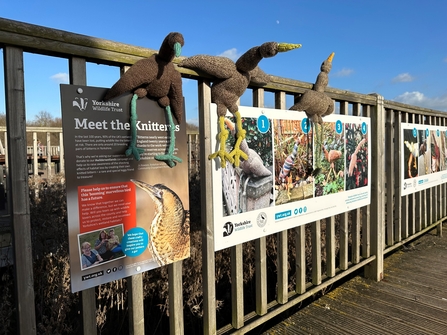Wetlands are a lifeline for rare and vulnerable species in Yorkshire, providing irreplaceable habitat to help our wildlife survive. Lakes, ponds, pools and bogs are increasingly important as alternate drought and flooding has led to more endangered species moving into the region or retreating to their remaining pockets for refuge.
Yorkshire Wildlife Trust cares for 25 wetland sites and is working hard to safeguard their future. Wetland reserves are the Trust’s most challenging reserves to manage, as water levels need to be adjusted, lake margins maintained and specialist equipment and support is needed to maintain their vital habitat for some of Yorkshire’s most important wildlife species.
Wetlands are also our most important reserves for wildlife habitat – providing open water, reed and willow margins, mudbanks as well as links to open countryside and woodland.
The hard work and expertise of Trust staff and volunteers managing these reserves has led to a number of recent successes and sightings, footage and photos are in the link below;
- Spectacular starling murmurations are currently putting on their incredible winter show at Ripon City Wetlands and in the Lower Derwent Valley.
- Rarely-seen water rails delighted visitors to Staveley, North Cave Wetlands and Adel Dam nature reserves throughout January. Secretive and shy birds, water rails are resident in the UK all year round but prefer to migrate under the cover of darkness, and are more often heard calling.
- Plans are underway to put up an osprey platform at Ripon City Wetlands nature reserve in North Yorkshire. Ospreys bred in the Yorkshire Dales last year for the first time in 200 years and the Trust hopes the birds may chose to visit and breed at the reserve in future seasons.
- New scrapes (seasonal water hollows) have been created for waders at Low Carr nature reserve, in the hope more birds will rest, feed and breed at the reserve. Similar work last winter at Potteric Carr led to a breeding record of black-winged stilts.
- A number of exciting sightings at Wheldrake Ings in December and January, including redhead smew, a female scaup and a mother otter with cubs – showing the mammals breeding again in the area in what is thought to be the first time in years.
- Timelapse footage shows volunteers planting 2900 reedbed plugs at North Cave Wetlands as part of a 25-acre extension to the reserve which will attract marsh harrier, bearded tits, bittern and spotted crake (watch here: https://www.youtube.com/watch?v=sKyZWQsKj5k)
Rachael Bice, CEO of Yorkshire Wildlife Trust, said;
“Today is the day for celebrating our beautiful and wilder wetlands in all of their bountiful variety. A home for wildlife from the common frog right through to the rare bittern and water vole, wetlands are abundant in wildlife. Lush pools, lakes and ponds, fringed by golden reeds, meadow or woodland are vital in helping us adapt better to a changing climate, and provide a peaceful place for restoration and relaxation.”
To mark the date, the Trust is also hosting a competition at Potteric Carr in Doncaster – where 20% of Yorkshire’s breeding population of bittern are found – asking visitors to vote on their favourite completed ‘knittern.’ The delightful knitted creations are in the shape of a bittern from a pattern created by the Trust and published last autumn. All of the knitterns have been created by generous members of the public to raise awareness for the Trust’s wetland work and for the endangered bittern.

